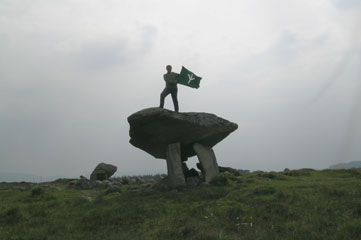| Le drapeau fomoire déployé sur la colline de Tara, demeure du "Ard Ri", le haut-roi d'Irlande, à côté de la "Lia Fail", la pierre sacrée du Destin amenée ici par les Tuatha Dé Danann selon le mythe irlandais. The Formori flag is deployed on the Hill of Tara, home of the "Ard Ri", the high king of Ireland, next to the "Lia Fail", the holy stone of Destiny, brought here by the Tuatha Dé Danann according to the Irish myth. |
 |
|
 |
Le drapeau flotte fièrement au cœur du "Grianan of Ailach", un fort du Comté de Donegal que la légende dit être l'œuvre des Tuatha Dé Danann. Son emplacement correspond à peu près à celui de la Bataille de Magh Ithe où les Fomoires auraient été défaits par les Partholoniens. The flag flies proudly inside the "Grianan of Ailach", a fort of the County of Donegal supposedly built by the Tuatha Dé Danann and located near the site of the Battle of Magh Ithe where the Formoris are said to have been defeated by the Partholonians. |
|
Le drapeau flotte sur le "Poisoned Glen", devant le Mt Errigal, le plus haut sommet de la chaîne des "Sept Sœurs", dans le Comté de Donegal. L'étymologie populaire veut que ce soit ici que Lug tua Balor-à-l'Oeil-Mauvais et que le poison de son oeil s'y soit répandu. En fait, le mot gaëlique pour "poison" (neimhe) est proche de celui pour "paradis" (neamh) et l'endroit devrait donc s'appeler "Heavenly Glen". The flag flies on the "Poisoned Glen" while in the background is Mt Errigal, the tallest of the "Seven Sisters" mountain range in the County of Donegal. Popular aetymology explains that this is the place where Lug killed Balor-of-the-evil-eye and that the poison of his eye spoiled the place. Actually, the Irish word for "poison" (neimhe) is close to the word for heaven (neamh) and the place's real name should be "Heavenly Glen". |
 |
|
 |
Une autre vue du "Poisoned Glen". Another view at "Poisoned Glen". |
| Le drapeau au sommet du fameux dolmen de Kilclooney, dans le Comté de Donegal. Il y avait beaucoup de vent. The flag on top of the famous Kilclooney Dolmen, in the County of Donegal. The weather was very windy. |
 |
|
 |
Le drapeau au pied du Knockarea Cairn, tombeau néolithique massif où aurait été ensevelie la reine guerrière mythique Medb (Maeve), dans le Comté de Sligo. Il y avait beaucoup de brume. The flag at the foot of the Knockarea Cairn, a massive Neolithic tomb inside which the mythical warrior queen Medb (Maeve) is said to have been burried, in the County of Sligo. The weather was very foggy. |
|
